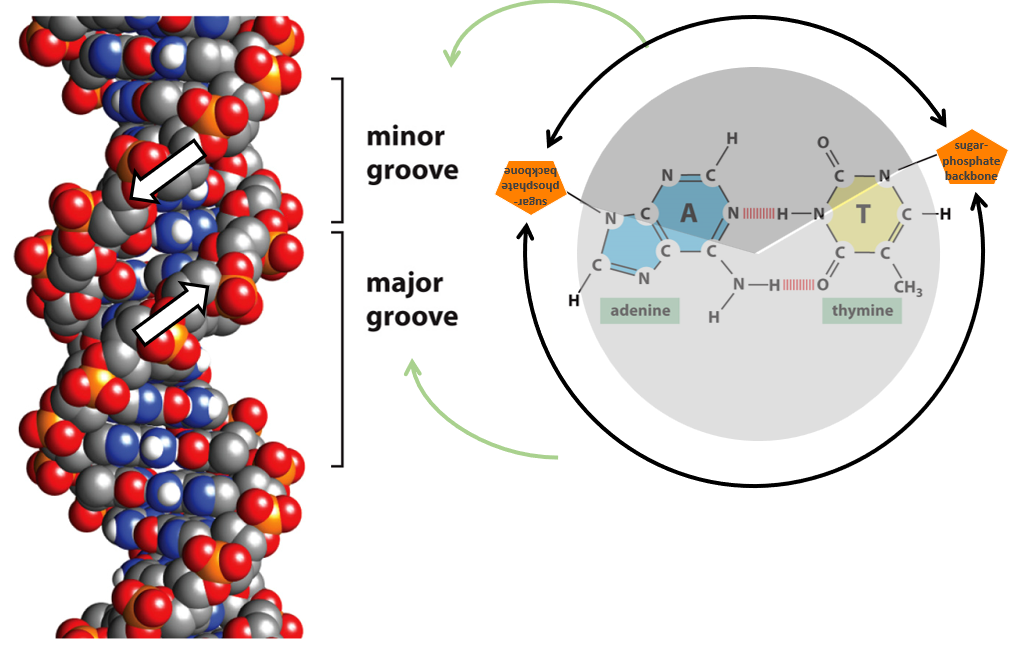Genetics - DNA Structure and Function
1/18
There's no tags or description
Looks like no tags are added yet.
Name | Mastery | Learn | Test | Matching | Spaced |
|---|
No study sessions yet.
19 Terms
What is the timeline of genetic discoveries?
Friedrich Miescher - 1868
Avery, MacLeod and MacCarthy - 1944
Alfred Hershey and Martha Chase - 1953
Rosalind Franklin - 1953
Watson and Crick - 1953
What was Miescher’s discovery?
Isolated ‘nuclein’ from human pus
Later renamed nucleic acid
Molecule had a high molecular weight, was acidic and contained lots of phosphorous
Obtained from other animal tissues and yeast cells
What was Avery, MacLeod and McCarthy’s discovery?
Completed transformation experiments
Used disease causing S-strain and harmless R-strain
Prepared an extract of different samples and implemented them into the R-strain
Only the DNA caused the R-strain to become disease causing
Part of the first evidence that DNA carries heritable information
What was Hershey and Chase’s discovery?
Used bacteriophages which contain only DNA and protein
Labelled DNA with 32P
Labelled protein with 35P
Only 32P was present in infected bacterial cells and passed to bacteriophage progeny
What was Franklin’s discovery?
Used X-Ray crystallography to identify a double helix structure of DNA
Proposed that phosphate molecules are located on the outside of the helix
What are the two most valuable properties of DNA?
Stability over time
Faithful replication
Why is DNA stability an important property?
Two strands means that mutations are less harmful as there are two strands to be affected
Why is faithful replication of DNA an important property?
Semi-conservative replication means one strand is parent DNA and the other is sister DNA
How can chromosomes and genes be viewed?
Using probes with fluorescent colours (DNA paint)
What is the physical structure of DNA?
Right handed double helix
Contains major and minor grooves due to hydrogen bonding between the bonded base pairs
What is the chemical structure of DNA?
Polymer made of nucleotides
Nucleotides are composed of a pentose sugar, phosphate group and a nitrogen-containing organic base
Four possible bases in DNA (A, T, C, G)
DNA strands are antiparallel and have directionality (5’ and 3’ ends)
DNA helix is made of two polynucleotide strands held by hydrogen bonds between complementary paired bases
What are the two categories of bases?
Pyrimidine base
Purine base
Cytosine, Thymine and Uracil are pyrimidine bases
Adenine and Guanine are purine bases
Purine base will always bond with a pyrimidine base
How can the strands of DNA be separated?
Heated to break the hydrogen bonds between strands
Why are major and minor grooves important in DNA?
DNA binding proteins need to be a specific shape to fit the major and minor grooves

What is the genome?
All the DNA in the nucleus of a cell or organelle
How is the genome organised?
Distributed among discrete units called chromosomes
Can be viewed as a karyotype
How is DNA organised within a cell?
Total DNA length for one cell is 2 metres long
Nucleus is 10 micrometres
DNA is wrapped around proteins to condense it
DNA wraps around 8 core histones twice to form nucleosomes
2x H2A
2x H2B
2x H3
2x H4
H1 brings the nucleosomes together to form a chromatin fibre
Chromatin is further condensed by scaffold proteins
What are the two types of chromatin?
Euchromatin - less compact DNA, contains DNA that is commonly transcribed
Heterochromatin - more compact DNA, contains DNA that is not commonly transcribed